Index to Trees & Shrubs in the Order Sapindales
Family: Anacardiaceae (Rhus, Mango, Pepper tree, Pistachio, Cashew Family)
362. Lannea discolor Life-long https://africawild-forum.com/viewtopic. ... 12#p261612
363. Lannea schweinfurthii stuhlmannii False Marula https://africawild-forum.com/viewtopic. ... 93#p230593
371. Ozoroa engleri Drooping Resin Tree https://africawild-forum.com/viewtopic. ... 95#p507295
360. Sclerocarya birrea Marula https://africawild-forum.com/viewtopic. ... 20#p253920
385.2 Searsia laevigata, Rhus laevigata Dune Currant https://africawild-forum.com/viewtopic. ... 20#p262120
386. Searsia lancea, Rhus lancea Karee https://africawild-forum.com/viewtopic. ... 79#p254879
Family: Balanitaceae (Torchwood Family)
251. Balanites maughamii Greenthorn Torchwood https://africawild-forum.com/viewtopic. ... 55#p230255
Family: Burseraceae (Frankincense and Myrrh Family)
279. Commiphora viminea Zebra-bark Corkwood https://africawild-forum.com/viewtopic. ... 95#p171707
Family: Meliaceae (Mahogany Family)
298. Ekebergia capensis Cape Ash, Dogplum https://africawild-forum.com/viewtopic. ... 09#p171709
295. Nymania capensis Chinese Lantern https://africawild-forum.com/viewtopic. ... 13#p171713
301. Trichilia emetica Natal Mahogany https://africawild-forum.com/viewtopic. ... 17#p171717
296.1. Turraea oblancifolia Lesser Honeysuckle Tree, Small Honeysuckle Tree https://africawild-forum.com/viewtopic. ... 88#p175188
Family: Sapindaceae (Litchi or Soap-berry Family)
433. Pappea capensis Jacket Plum https://africawild-forum.com/viewtopic. ... 14#p261014
Africa Wild Tree & Shrub Book - Order Sapindales
Moderator: Klipspringer
Re: Africa Wild Tree & Shrub Book - Order Sapindales
279. Zebra-bark corkwood Commiphora viminea (Sebrabaskanniedood)
Order: Sapindales. Family: Burseraceae

Mapungubwe National Park
Description
Small to medium-sized, exceptionally twiggy, deciduous single-stemmed tree or shrub. Bark grey with distinctive dark blackish warty horizontal bands, hence the common name. Bark of older trees peels in horizontal bands. Simple blue-green leaves with a thoothed edge at the top third (45 x 25 mm); leaves are clustered in rosettes. Leaves are covered by a thin, greyish, powdery layer. Flowers (male and female on different trees) in small inconspicuous clusters on the spur-branchlets, yellowish green, appearing just before or with the new leaves. Fruit ellipsoid, up to 1.3 cm long, pointed, hairless, reddish-brown when ripe, splitting to reveal a black seed with a 4-lobed yellow pseudo-aril, almost surrounding the stone which covers the seed.
Distribution
Botswana, Mozambique, northern Namibia, Kenya, Tanzania, Zimbabwe and Limpopo, Mpumalanga, South Africa
Habitat
It occurs in hot, arid bushveld, particularly with Colophospermum mopane.
Order: Sapindales. Family: Burseraceae

Mapungubwe National Park
Description
Small to medium-sized, exceptionally twiggy, deciduous single-stemmed tree or shrub. Bark grey with distinctive dark blackish warty horizontal bands, hence the common name. Bark of older trees peels in horizontal bands. Simple blue-green leaves with a thoothed edge at the top third (45 x 25 mm); leaves are clustered in rosettes. Leaves are covered by a thin, greyish, powdery layer. Flowers (male and female on different trees) in small inconspicuous clusters on the spur-branchlets, yellowish green, appearing just before or with the new leaves. Fruit ellipsoid, up to 1.3 cm long, pointed, hairless, reddish-brown when ripe, splitting to reveal a black seed with a 4-lobed yellow pseudo-aril, almost surrounding the stone which covers the seed.
Distribution
Botswana, Mozambique, northern Namibia, Kenya, Tanzania, Zimbabwe and Limpopo, Mpumalanga, South Africa
Habitat
It occurs in hot, arid bushveld, particularly with Colophospermum mopane.
Re: Africa Wild Tree & Shrub Book - Order Sapindales
298. Cape Ash, Dogplum Ekebergia capensis (Essenhout)
Order: Sapindales. Family: Meliaceae

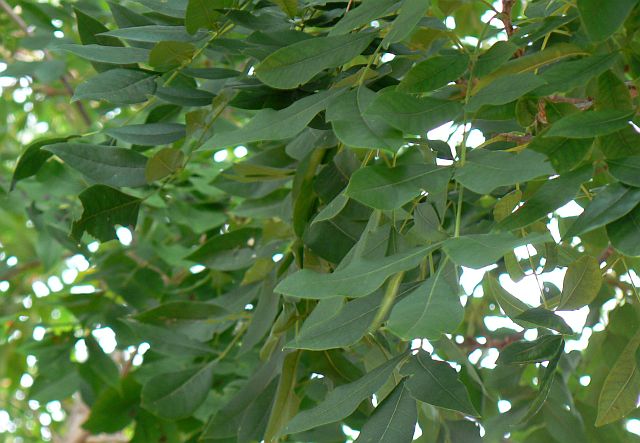
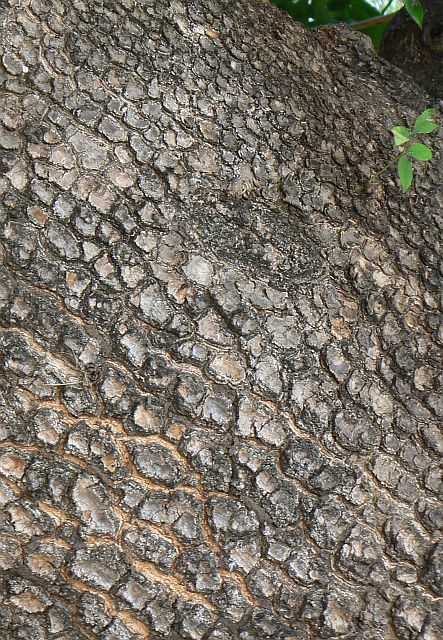
Kruger National Park, Letaba
Description
The Cape Ash is a large evergreen or semi-deciduous, medium-sized to large tree, 7-20 (max. 35) m tall.
Stem swollen at base; branching is erect, then spreading and finally drooping, giving a moderately heavy, flattish crown.
The main stem of E. capensis is characterised by a rough light grey to almost black bark, with few buttress roots at the base.
The large glossy green leaves that are often tinged with a pinkish patch, or pink edges are pinnate. Leaves compound, 10-36 cm long, 8-18 cm broad, with common midrib, sometimes slightly winged, alternate. Leaflets usually in 3-5 pairs, occasionally up to 7, with a terminal leaflet, leathery, opposite, almost stalkless and smooth; may be long and rather narrow, broadly oval or almost egg-shaped.
The small sweetly scented flowers are white or greenish-yellow, occasionally also with pink tinge, 5-petalled.
They appear in loose sprays, about 8 cm long, in the summer months (September to November). Each panicle consists of 12-70 flowers, making the tree very conspicuous when in full bloom. Male and female on different trees.
A fleshy fruit containing four seeds appears green and then turns bright red as it ripens in autumn. Fruits are round, resembling small apples, thin skinned, almost spherical, 1-2 cm in diameter, succulent.
Cape Ash is often confused with the Wild Plum (Harpephyllum caffrum). However, the leaves of Wild Plum are stiff and not drooping, they are also sickle-shaped.
Distribution
The Cape Ash grows from the Eastern Cape northwards through KwaZulu-Natal, Swaziland, southern Mozambique, the Limpopo Province and into Zimbabwe. It also occurs as far north as Uganda, Ethiopia and the D.R.C.
Habitat
It occurs in a number of different habitats, from high altitude evergreen montane forests to riverine or coastal forests, and from the sea level to about 1500 m above sea level.
Links: PlantZAfrica; Braam Van Wyk, Piet Van Wyk: Field Guide to Trees of Southern Africa; Garden Route Guide: 2006 Edition: From Still Bay to Storms River
Order: Sapindales. Family: Meliaceae



Kruger National Park, Letaba
Description
The Cape Ash is a large evergreen or semi-deciduous, medium-sized to large tree, 7-20 (max. 35) m tall.
Stem swollen at base; branching is erect, then spreading and finally drooping, giving a moderately heavy, flattish crown.
The main stem of E. capensis is characterised by a rough light grey to almost black bark, with few buttress roots at the base.
The large glossy green leaves that are often tinged with a pinkish patch, or pink edges are pinnate. Leaves compound, 10-36 cm long, 8-18 cm broad, with common midrib, sometimes slightly winged, alternate. Leaflets usually in 3-5 pairs, occasionally up to 7, with a terminal leaflet, leathery, opposite, almost stalkless and smooth; may be long and rather narrow, broadly oval or almost egg-shaped.
The small sweetly scented flowers are white or greenish-yellow, occasionally also with pink tinge, 5-petalled.
They appear in loose sprays, about 8 cm long, in the summer months (September to November). Each panicle consists of 12-70 flowers, making the tree very conspicuous when in full bloom. Male and female on different trees.
A fleshy fruit containing four seeds appears green and then turns bright red as it ripens in autumn. Fruits are round, resembling small apples, thin skinned, almost spherical, 1-2 cm in diameter, succulent.
Cape Ash is often confused with the Wild Plum (Harpephyllum caffrum). However, the leaves of Wild Plum are stiff and not drooping, they are also sickle-shaped.
Distribution
The Cape Ash grows from the Eastern Cape northwards through KwaZulu-Natal, Swaziland, southern Mozambique, the Limpopo Province and into Zimbabwe. It also occurs as far north as Uganda, Ethiopia and the D.R.C.
Habitat
It occurs in a number of different habitats, from high altitude evergreen montane forests to riverine or coastal forests, and from the sea level to about 1500 m above sea level.
Links: PlantZAfrica; Braam Van Wyk, Piet Van Wyk: Field Guide to Trees of Southern Africa; Garden Route Guide: 2006 Edition: From Still Bay to Storms River
Re: Africa Wild Tree & Shrub Book - Order Sapindales
295. Chinese Lantern Nymania capensis (Klapperbos)
Order: Sapindales. Family: Meliaceae

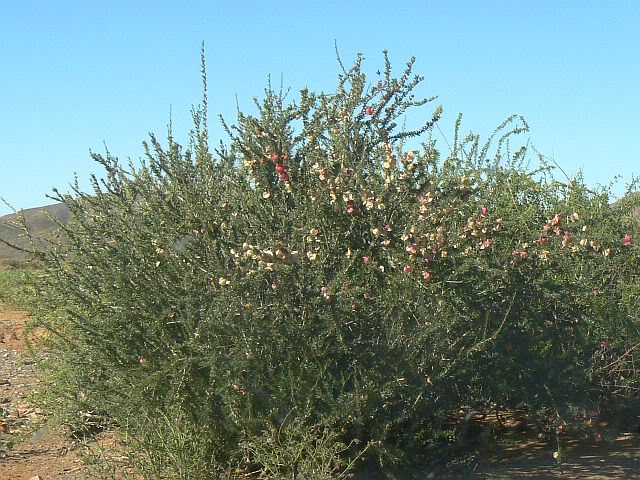
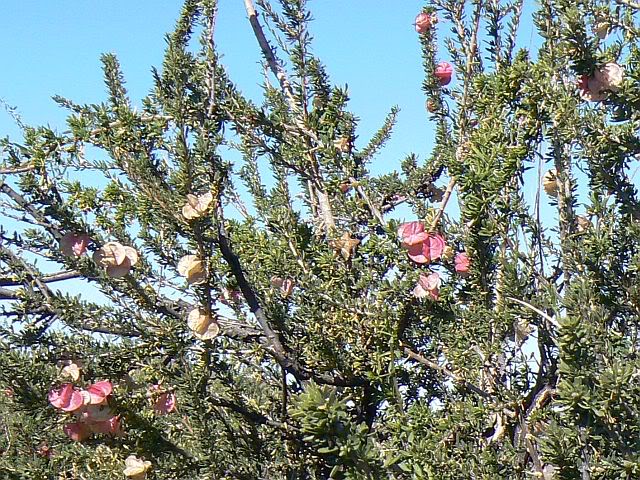
Richtersveld National Park
Description
An evergreen large rigid shrub or small tree up to 6m tall (normal height is not more than 3 m) with pinkish, puffy seedheads. The leaves are stiff and leathery in texture, almost spear-shaped. The dull or bright red flowers are solitary and borne in the leaf axils, tubular to bell-shaped, the floral parts occur in fours; they appear in winter. Seeds are produced in papery, inflated capsules. The seeds are pea-shaped and brown.
Distribution
It occurs in southern Namibia, the Richtersveld, Namaqualand, Ceres Tanqua Karoo, Bushmanland, Worcester Robertson Karoo and the Little Karoo.
Habitat
It prefers hot, dry, rocky scrub-veld, but also occurs near dry, sandy rivers. It grows predominately in the winter rainfall areas that receive little more than 120 mm annually. They are relatively frost tolerant, being able to survive temperatures of - 4°C. They can also survive in extreme heat, 44°C and above.
Links: Braam Van Wyk: A Photographic Guide to Wild Flowers of South Africa
Order: Sapindales. Family: Meliaceae



Richtersveld National Park
Description
An evergreen large rigid shrub or small tree up to 6m tall (normal height is not more than 3 m) with pinkish, puffy seedheads. The leaves are stiff and leathery in texture, almost spear-shaped. The dull or bright red flowers are solitary and borne in the leaf axils, tubular to bell-shaped, the floral parts occur in fours; they appear in winter. Seeds are produced in papery, inflated capsules. The seeds are pea-shaped and brown.
Distribution
It occurs in southern Namibia, the Richtersveld, Namaqualand, Ceres Tanqua Karoo, Bushmanland, Worcester Robertson Karoo and the Little Karoo.
Habitat
It prefers hot, dry, rocky scrub-veld, but also occurs near dry, sandy rivers. It grows predominately in the winter rainfall areas that receive little more than 120 mm annually. They are relatively frost tolerant, being able to survive temperatures of - 4°C. They can also survive in extreme heat, 44°C and above.
Links: Braam Van Wyk: A Photographic Guide to Wild Flowers of South Africa
Re: Africa Wild Tree & Shrub Book - Order Sapindales
301. Natal Mahogany Trichilia emetica (Rooiessenhout)
Order: Sapindales. Family: Meliaceae
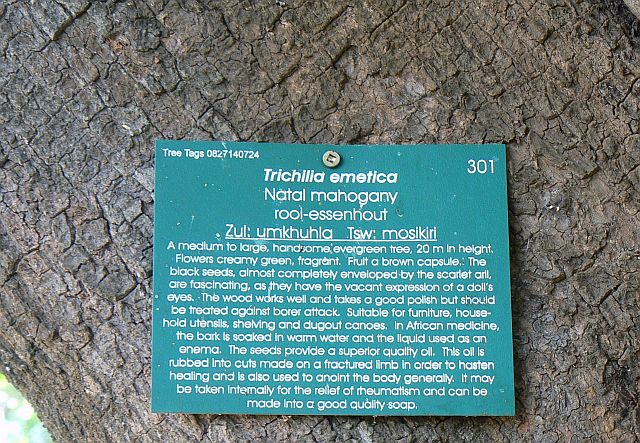
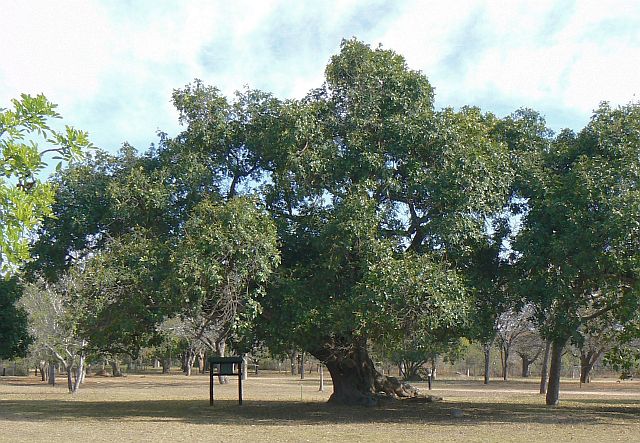
Pretoriuskop, Kruger National Park
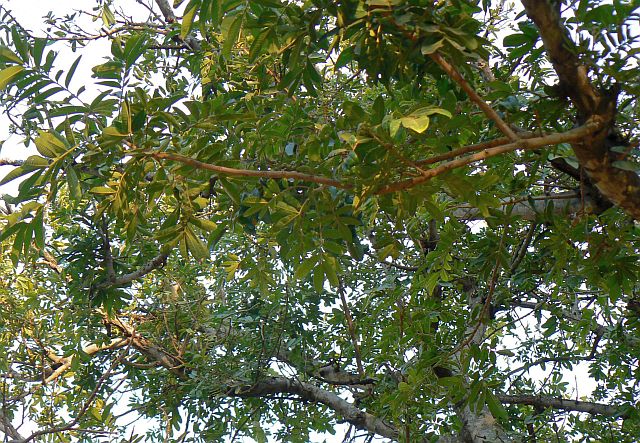
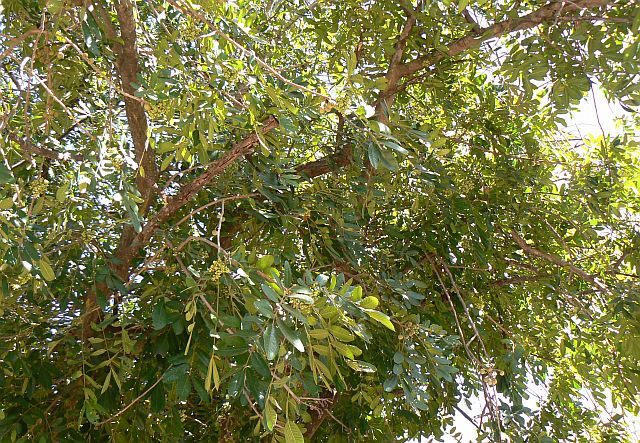
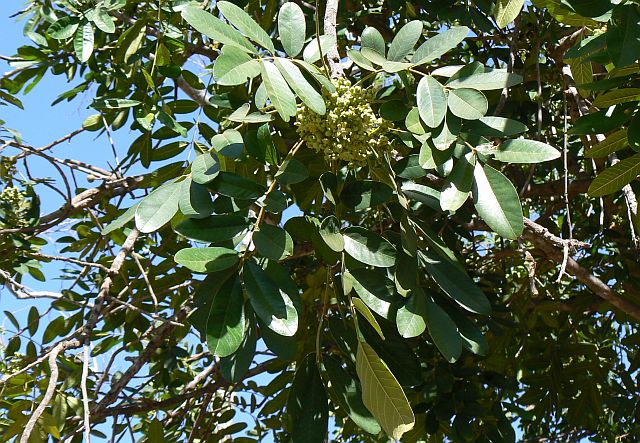

Flower

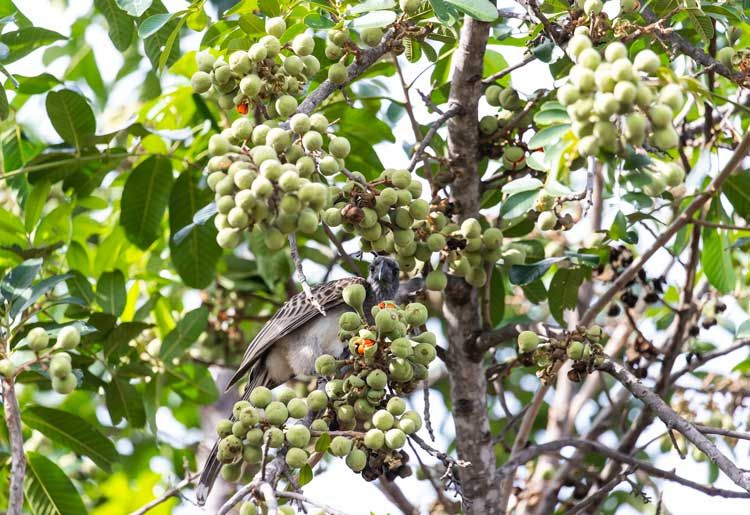 © Pumbaa
© Pumbaa
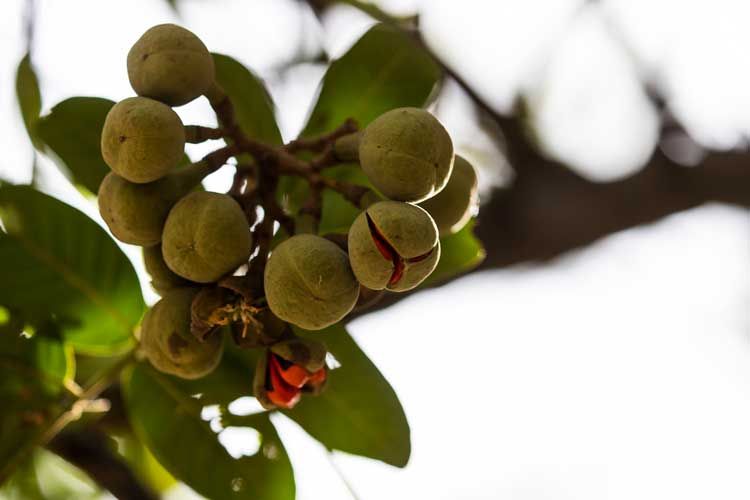 © Pumbaa
© Pumbaa
Fruit, Babalala picnic spot
Description
A medium-sized to large evergreen tree with a wide spreading crown. The handsome leaves are a glossy dark green. Leaves imparipinnate with 3-5 pairs of leaflets and a terminal leaflet; leaflets opposite or subopposite, elliptic or oblong-elliptic, mostly up to 12 cm, glossy dark green above, densely covered in curled hairs below, midrib, sunken, lateral veins closely spaced; margins entire, often rolled under. The sweet smelling flowers are a creamy green colour and are produced in tight bunches. Fruit a spherical woody capsule, velvety, pale green, c. 2.5 cm in diameter, splitting into 2-3 valves, revealing black seeds, largely hidden in a bright red aril.The bark is smooth and is dark brown to grey in colour. This is a deciduous tree, which can grow up to 20m tall. The round fruits split when mature, revealing striking red and black seeds which are eaten by birds. Occasionally a tree will only bear male flowers, so will never fruit.
The Natal mahogany, Trichilia emetica, is a tree that superficially resembles the forest mahogany. The two can however be readily distinguished from one another by observing some basic features: T. emetica produces leaflets containing 13-16 pairs of side veins, whereas only 8-12 are evident in T. dregeana and those of the former are also less glossy and not as dark in colour with an apex that is more rounded that the acute to acuminate tips seen in T. dregeana. In addition, the fruit capsules have a distinct neck joining them to their stalk, a feature absent in T. dregeana.
Distribution
From Sudan to KwaZulu-Natal. Provincial distribution in South Africa: KwaZulu-Natal, Limpopo, Mpumalanga.
Habitat
Open woodland and riverine bush.
Links: Wild About Trees

Kruger National Park, Tshokwane Picnic Spot
Order: Sapindales. Family: Meliaceae


Pretoriuskop, Kruger National Park




Flower

 © Pumbaa
© Pumbaa © Pumbaa
© PumbaaFruit, Babalala picnic spot
Description
A medium-sized to large evergreen tree with a wide spreading crown. The handsome leaves are a glossy dark green. Leaves imparipinnate with 3-5 pairs of leaflets and a terminal leaflet; leaflets opposite or subopposite, elliptic or oblong-elliptic, mostly up to 12 cm, glossy dark green above, densely covered in curled hairs below, midrib, sunken, lateral veins closely spaced; margins entire, often rolled under. The sweet smelling flowers are a creamy green colour and are produced in tight bunches. Fruit a spherical woody capsule, velvety, pale green, c. 2.5 cm in diameter, splitting into 2-3 valves, revealing black seeds, largely hidden in a bright red aril.The bark is smooth and is dark brown to grey in colour. This is a deciduous tree, which can grow up to 20m tall. The round fruits split when mature, revealing striking red and black seeds which are eaten by birds. Occasionally a tree will only bear male flowers, so will never fruit.
The Natal mahogany, Trichilia emetica, is a tree that superficially resembles the forest mahogany. The two can however be readily distinguished from one another by observing some basic features: T. emetica produces leaflets containing 13-16 pairs of side veins, whereas only 8-12 are evident in T. dregeana and those of the former are also less glossy and not as dark in colour with an apex that is more rounded that the acute to acuminate tips seen in T. dregeana. In addition, the fruit capsules have a distinct neck joining them to their stalk, a feature absent in T. dregeana.
Distribution
From Sudan to KwaZulu-Natal. Provincial distribution in South Africa: KwaZulu-Natal, Limpopo, Mpumalanga.
Habitat
Open woodland and riverine bush.
Links: Wild About Trees

Kruger National Park, Tshokwane Picnic Spot
Re: Africa Wild Tree & Shrub Book - Order Sapindales
296.1. Lesser Honeysuckle Tree, Small Honeysuckle Tree Turraea oblancifolia (Kleinkamperfoelieboom )
Order: Sapindales. Family: Meliaceae
 © mposthumus
© mposthumus
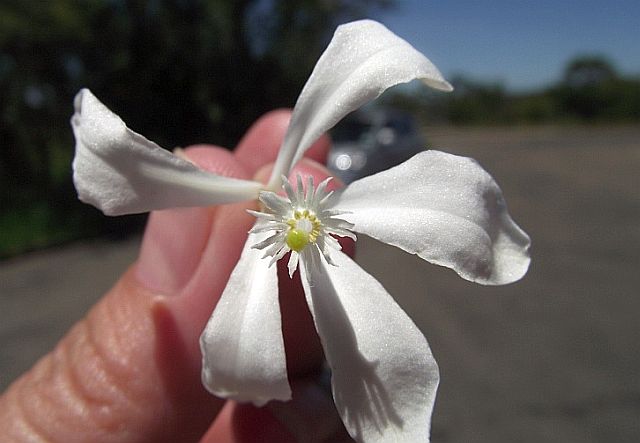 © mposthumus
© mposthumus
Kruger National Park, Nkumbe view point
Description
Deciduous sparse shrub or occasionally a small tree to 3 m. Branches with rusty-brown lenticels young shoots very finely hairy. The leaves are a dark glossy green, clustered on short side shoots. Leaves alternate or often clustered on dwarf spur branchlets, to 5 × 2.5 cm but usually only 3-3.5 cm long, very variable in shape, elliptic to oblanceolate, often with the apical part more or less 3-lobed or triangular, glossy green, hairless; margin entire.
The flowers are produced abundantly in small clusters amongst the leaves during mid- to late summer (Jan.-Feb.). Each flower has 5 free petals, and 10 stamens fused to form a narrow cylindrical tube. Flowers in 1-3 flowered axillary clusters, large, pure white; petals narrow, up to 3.5 cm long; staminal tube 2.5-3.5 cm long.
Fruit a distinct 5-lobed woody green capsule, c. 2.5 cm in diameter, like a miniature pumpkin, splitting and peeling back to reveal shiny orange-red, kidney-shaped seeds (Feb.-June).
Fruits and flowers may occur on the tree together.
Distribution
Botswana, Mozambique, Zimbabwe, Swaziland and South Africa (Eastern Cape, Gauteng, KwaZulu-Natal, Limpopo, Mpumalanga, North West).
Habitat
On rocky hillsides and kopjes, in coastal forest, bushveld, coastal dunes and rocky outcrops on the east coast.
Links: PlantZAfrica
Order: Sapindales. Family: Meliaceae
 © mposthumus
© mposthumus © mposthumus
© mposthumusKruger National Park, Nkumbe view point
Description
Deciduous sparse shrub or occasionally a small tree to 3 m. Branches with rusty-brown lenticels young shoots very finely hairy. The leaves are a dark glossy green, clustered on short side shoots. Leaves alternate or often clustered on dwarf spur branchlets, to 5 × 2.5 cm but usually only 3-3.5 cm long, very variable in shape, elliptic to oblanceolate, often with the apical part more or less 3-lobed or triangular, glossy green, hairless; margin entire.
The flowers are produced abundantly in small clusters amongst the leaves during mid- to late summer (Jan.-Feb.). Each flower has 5 free petals, and 10 stamens fused to form a narrow cylindrical tube. Flowers in 1-3 flowered axillary clusters, large, pure white; petals narrow, up to 3.5 cm long; staminal tube 2.5-3.5 cm long.
Fruit a distinct 5-lobed woody green capsule, c. 2.5 cm in diameter, like a miniature pumpkin, splitting and peeling back to reveal shiny orange-red, kidney-shaped seeds (Feb.-June).
Fruits and flowers may occur on the tree together.
Distribution
Botswana, Mozambique, Zimbabwe, Swaziland and South Africa (Eastern Cape, Gauteng, KwaZulu-Natal, Limpopo, Mpumalanga, North West).
Habitat
On rocky hillsides and kopjes, in coastal forest, bushveld, coastal dunes and rocky outcrops on the east coast.
Links: PlantZAfrica
Re: Africa Wild Tree & Shrub Book - Order Sapindales
251. Greenthorn Torchwood Balanites maughamii maughamii (Groendoring)
Order: Sapindales. Family: Balnitaceae (recently sometimes placed in Zygophyllaceae)

Tembe Elephant Park, KwaZulu-Natal
Description
A medium to large upright tree, 10-20 m high, much branched. It is deciduous to semi-deciduous. It typically has a spreading crown and the older trunks are greyish. The branchlets are greyish green and hairy. Usually the zigzag branchlets are strongly armed with unequally forked spines forming a y-shape, sometimes simple; or they are unarmed, usually the fruit-bearing branches, sometimes with very small spines. The spines are very prominent, especially on sterile branches where they may have 2 to 3 prongs. The fruiting branches have thinner, straight thorns. On older branches they are grey-brown.
Leaves are leathery with velvety hairs when young, grey-green, alternatively arranged, compound, with two elliptic to ovate to round leaflets; the margin is entire, the apex is rounded and the base tapering. The central vein of the leaf is slightly off-centre and the base is unequal.
The bark is grey and smooth in young trees. In older trees it is rough and breaks into small, irregular blocks.
Small, inconspicuous, scented, star-shaped flowers are covered by velvety hairs. The tree only flowers every second or third year (July to Octpber) (20 mm).
The big, oval, plum-like fruit is pale brown and covered with fine hairs. The flesh is thin and bitter. It appears from November to January, and is yellowish when ripe from May. Ripe fruit is dropped with the stem attached, from May to July (30-50 x 20-30 mm).
Distribution
From Tanzania to KwaZulu-Natal, South Africa.
Habitat
Found in small colonies in the bushveld, sand forest, on sandstone outcrops, along river banks, near springs and around pans.
Links: Trees and Shrubs of Mpumalanga and Kruger National Park
Order: Sapindales. Family: Balnitaceae (recently sometimes placed in Zygophyllaceae)

Tembe Elephant Park, KwaZulu-Natal
Description
A medium to large upright tree, 10-20 m high, much branched. It is deciduous to semi-deciduous. It typically has a spreading crown and the older trunks are greyish. The branchlets are greyish green and hairy. Usually the zigzag branchlets are strongly armed with unequally forked spines forming a y-shape, sometimes simple; or they are unarmed, usually the fruit-bearing branches, sometimes with very small spines. The spines are very prominent, especially on sterile branches where they may have 2 to 3 prongs. The fruiting branches have thinner, straight thorns. On older branches they are grey-brown.
Leaves are leathery with velvety hairs when young, grey-green, alternatively arranged, compound, with two elliptic to ovate to round leaflets; the margin is entire, the apex is rounded and the base tapering. The central vein of the leaf is slightly off-centre and the base is unequal.
The bark is grey and smooth in young trees. In older trees it is rough and breaks into small, irregular blocks.
Small, inconspicuous, scented, star-shaped flowers are covered by velvety hairs. The tree only flowers every second or third year (July to Octpber) (20 mm).
The big, oval, plum-like fruit is pale brown and covered with fine hairs. The flesh is thin and bitter. It appears from November to January, and is yellowish when ripe from May. Ripe fruit is dropped with the stem attached, from May to July (30-50 x 20-30 mm).
Distribution
From Tanzania to KwaZulu-Natal, South Africa.
Habitat
Found in small colonies in the bushveld, sand forest, on sandstone outcrops, along river banks, near springs and around pans.
Links: Trees and Shrubs of Mpumalanga and Kruger National Park
Re: Africa Wild Tree & Shrub Book - Order Sapindales
363. False Marula Lannea schweinfurthii stuhlmannii (Valsmaroela)
Order: Sapindales. Family: Anacardiaceae
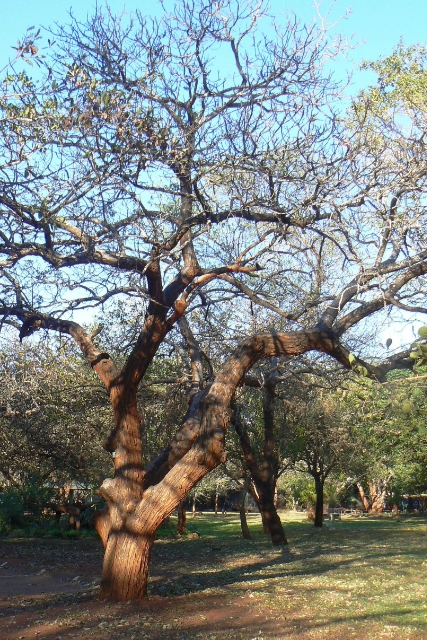
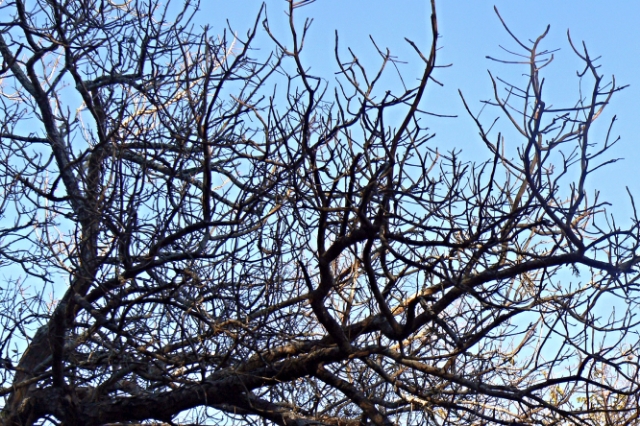
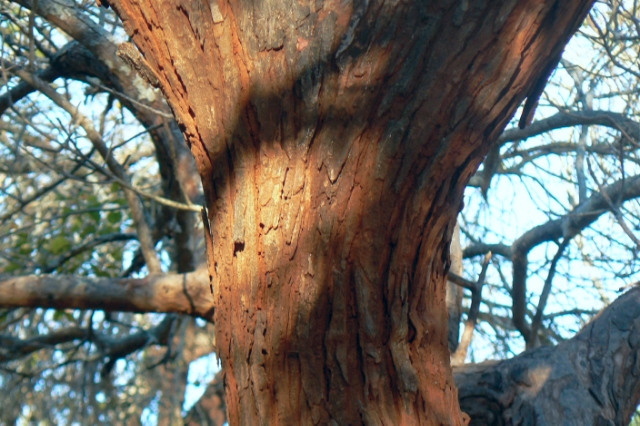
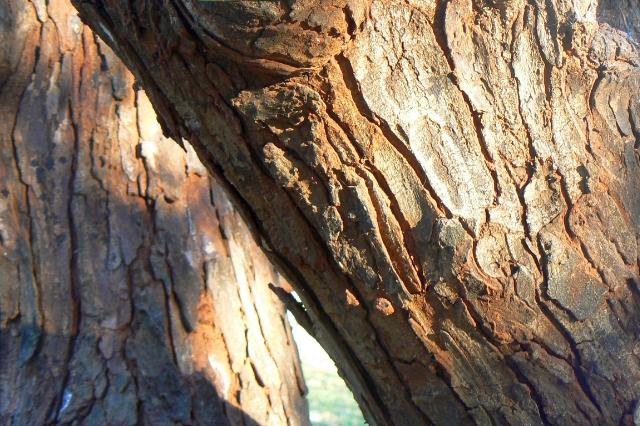
Kruger National Park, Crocodile Bridge
Description
Small to medium-sized tree (9-14 m) with single stem and spreading and drooping branches. Bark grey, reticulately or longitudinally fissured, flaking to reveal a lighter underbark. Leaves crowded at the ends of branches, imparipinnate with 1-5 pairs of leaflets and a terminal leaflet; leaflets broadly ovate or elliptic, 2-9 cm long, terminal leaflet larger than lateral leaflets, pale green, young leaflets densely hairy, more or less hairless when mature; apex abruptly but broadly tapering; margin entire. Flowers unisexual on different trees in axillary spikes, yellow-green. Fruits oblong-ellipsoid, c. 1.2 cm long, fleshy, tipped with 4 small points, dark reddish-brown when ripe.
Distribution
Kenya, Uganda, Tanzania, Zanzibar, Malawi, Mozambique, Zambia, Zimbabwe, Swaziland and South Africa (KwaZulu-Natal, Limpopo, Mpumalanga).
Habitat
In deciduous woodland, river valleys and on rocky outcrops, often on termite mounds.
Links: Trees and Shrubs of Mpumalanga and Kruger National Park
Order: Sapindales. Family: Anacardiaceae




Kruger National Park, Crocodile Bridge
Description
Small to medium-sized tree (9-14 m) with single stem and spreading and drooping branches. Bark grey, reticulately or longitudinally fissured, flaking to reveal a lighter underbark. Leaves crowded at the ends of branches, imparipinnate with 1-5 pairs of leaflets and a terminal leaflet; leaflets broadly ovate or elliptic, 2-9 cm long, terminal leaflet larger than lateral leaflets, pale green, young leaflets densely hairy, more or less hairless when mature; apex abruptly but broadly tapering; margin entire. Flowers unisexual on different trees in axillary spikes, yellow-green. Fruits oblong-ellipsoid, c. 1.2 cm long, fleshy, tipped with 4 small points, dark reddish-brown when ripe.
Distribution
Kenya, Uganda, Tanzania, Zanzibar, Malawi, Mozambique, Zambia, Zimbabwe, Swaziland and South Africa (KwaZulu-Natal, Limpopo, Mpumalanga).
Habitat
In deciduous woodland, river valleys and on rocky outcrops, often on termite mounds.
Links: Trees and Shrubs of Mpumalanga and Kruger National Park
Re: Africa Wild Tree & Shrub Book - Order Sapindales
360. Marula Sclerocarya birrea (Maroela)
Order: Sapindales. Family: Anacardiaceae
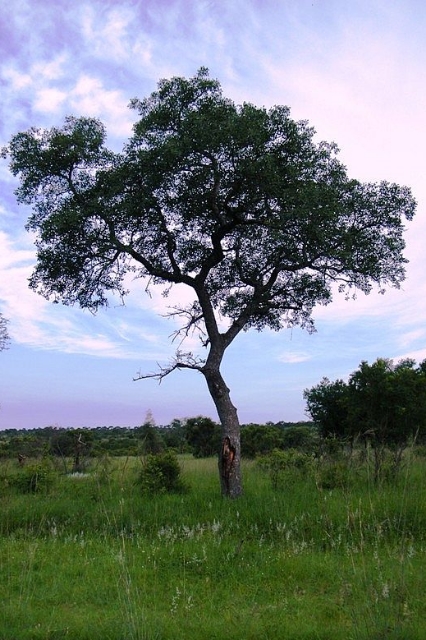 © Richprins
© Richprins
Kruger National Park
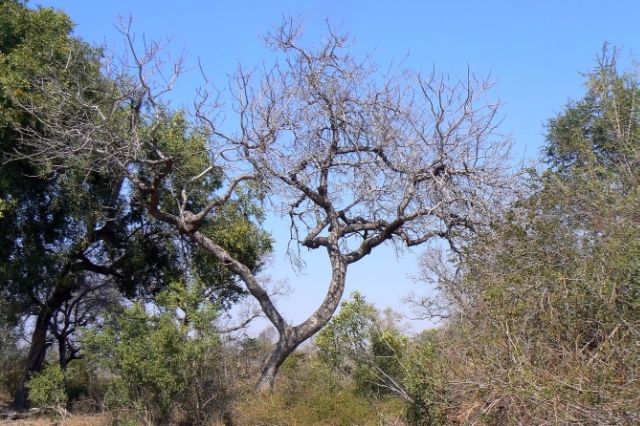 © Toko
© Toko
Kruger National Park, H2-2
Description
A medium to large tree, usually 9 m tall, but trees up to 18 m have been recorded. It is a single-trunked deciduous tree, dividing high up into a few bare branches forming a semi-circular canopy. The bark often peels in conspicuous, characteristic rounded depressions, revealing smooth, pink-brown under-bark. In summer blue-green, Once compound leaves hang crowded towards the end of thickened twigs. In winter the bare twigs stand out like stubby fingers. Unripe green and ripe yellow fruit are often seen on the ground under the female trees (January to March).
The bark is grey and usually peels off in flat, round disks, exposing the underlying light yellow tissue. Young trees often have conspicuous spines up to 150 mm long, which make the trees look like a different species!
Once Compound, alternate leaves have 3 - 7 pairs of opposite, elliptic leaflets with a single leaflet at the tip. New leaves are coppery, turning shiny bright green before they mature to blue-green above and paler below. Leaflets have a tapering tip and smooth margin. Leaf- and leaflet-stalks are pinkish (Leaf: 150 - 300 mm; leaflet: 30 - 100 x 15 - 40 mm).
Flower-buds are plum-red. They appear with, or before, the new leaves in spring. Male and female flowers grow on separate trees. Inconspicuous pink-and-white male flowers grow in sprays at the ends of branches and twigs. Female flowers are reddish-green and grow singly from the twig ends.
Marulas are part of the Mango Family and the fruit therefore has a central pip surrounded by flesh. The fruit is oval, plum-sized and thinly fleshed. It only develops on female trees. It ripens to pale yellow, giving off a strong fruity smell (Jan - Mar). Often the central woody stones, with two or three ‘seed-holes’, can be found on the ground near the tree, the rest of the fruit having been eaten by animals and birds (Fruit: 40 x 40 mm).
Distribution
The marula is widespread in Africa from Ethiopia in the north to KwaZulu-Natal in the south. In South Africa it is found in Gauteng KwaZulu-Natal, Limpopo, Mpumalanga, North West
.
Habitat
It occurs naturally in various types of woodland, on sandy soil or occasionally sandy loam.
Links: SAPPI Tree Spotting - Lowveld
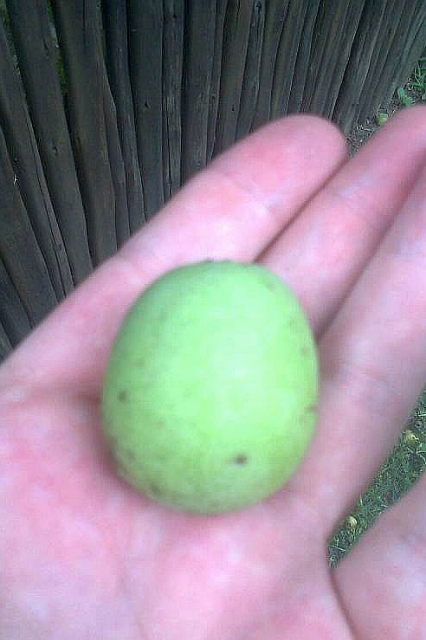 © Richprins
© Richprins
 © Richprins
© Richprins
 © Richprins
© Richprins
Order: Sapindales. Family: Anacardiaceae
 © Richprins
© RichprinsKruger National Park
 © Toko
© TokoKruger National Park, H2-2
Description
A medium to large tree, usually 9 m tall, but trees up to 18 m have been recorded. It is a single-trunked deciduous tree, dividing high up into a few bare branches forming a semi-circular canopy. The bark often peels in conspicuous, characteristic rounded depressions, revealing smooth, pink-brown under-bark. In summer blue-green, Once compound leaves hang crowded towards the end of thickened twigs. In winter the bare twigs stand out like stubby fingers. Unripe green and ripe yellow fruit are often seen on the ground under the female trees (January to March).
The bark is grey and usually peels off in flat, round disks, exposing the underlying light yellow tissue. Young trees often have conspicuous spines up to 150 mm long, which make the trees look like a different species!
Once Compound, alternate leaves have 3 - 7 pairs of opposite, elliptic leaflets with a single leaflet at the tip. New leaves are coppery, turning shiny bright green before they mature to blue-green above and paler below. Leaflets have a tapering tip and smooth margin. Leaf- and leaflet-stalks are pinkish (Leaf: 150 - 300 mm; leaflet: 30 - 100 x 15 - 40 mm).
Flower-buds are plum-red. They appear with, or before, the new leaves in spring. Male and female flowers grow on separate trees. Inconspicuous pink-and-white male flowers grow in sprays at the ends of branches and twigs. Female flowers are reddish-green and grow singly from the twig ends.
Marulas are part of the Mango Family and the fruit therefore has a central pip surrounded by flesh. The fruit is oval, plum-sized and thinly fleshed. It only develops on female trees. It ripens to pale yellow, giving off a strong fruity smell (Jan - Mar). Often the central woody stones, with two or three ‘seed-holes’, can be found on the ground near the tree, the rest of the fruit having been eaten by animals and birds (Fruit: 40 x 40 mm).
Distribution
The marula is widespread in Africa from Ethiopia in the north to KwaZulu-Natal in the south. In South Africa it is found in Gauteng KwaZulu-Natal, Limpopo, Mpumalanga, North West
.
Habitat
It occurs naturally in various types of woodland, on sandy soil or occasionally sandy loam.
Links: SAPPI Tree Spotting - Lowveld
 © Richprins
© Richprins © Richprins
© Richprins © Richprins
© RichprinsRe: Africa Wild Tree & Shrub Book - Order Sapindales
386. Karee, Karee-rhus Searsia lancea, Rhus lancea
Order: Sapindales. Family: Anacardiaceae
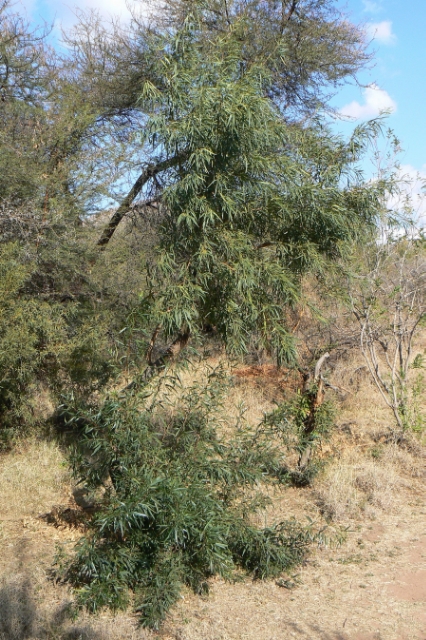 © Toko
© Toko
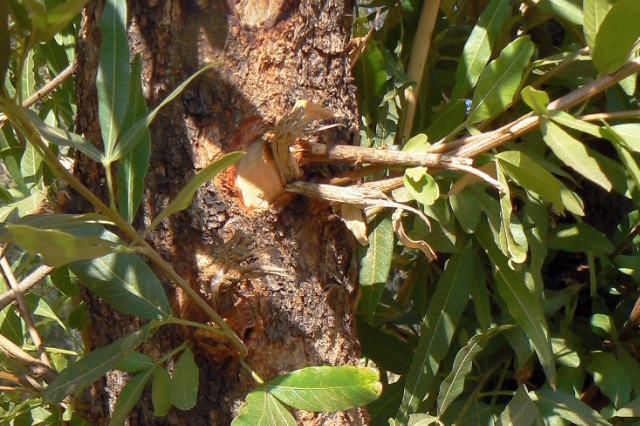 © Toko
© Toko
 © Toko
© Toko
Marakele National Park
Description
Large shrub or rounded tree, usually 6 to 8 m tall. It is usually a single-stemmed, low branching tree which has a dense, soft, round canopy. The karee has a course textured bark and on older specimens it is dark grey or brown in colour while on young branches and trees it is a reddish brown-colour. The leaves are trifoliate (a compound leaf with three leaflets), possessing narrowly lanceolate (lance shaped) leaflets, up to 12 mm long. The leaves are dark green above and paler green below. They do not have any hairs on them and the margins of the leaves are entire. The leaves are leathery and are often sickle shaped. The small, inconspicuous flowers are presented as much-branched sprays which are greenish-yellow in colour and are produced from June until September. The male and female flowers occur on separate trees. The fruit are small (up to 5 mm in diameter), round, slightly flattened and covered with a thin fleshy layer which is glossy and yellowish to brown when ripe. The fruits are produced from September until January.
Distribution
The karee occurs from Zambia in the north to the Western Cape in the south. Provincial distribution in South Africa: Eastern Cape, Free State, Gauteng, Limpopo, Mpumalanga, Northern Cape, North West, Western Cape. Very widesprad in Namibia.
Habitat
The karee occurs naturally in Acacia woodland and along drainage lines, rivers and streams. It is often found growing on lime rich substrates.
Links: Trees and Shrubs of Mpumalanga and Kruger National Park. Ernst Schmidt, Mervyn Lotter, Warren McCleland; Tree Atlas of Namibia
Order: Sapindales. Family: Anacardiaceae
 © Toko
© Toko  © Toko
© Toko © Toko
© TokoMarakele National Park
Description
Large shrub or rounded tree, usually 6 to 8 m tall. It is usually a single-stemmed, low branching tree which has a dense, soft, round canopy. The karee has a course textured bark and on older specimens it is dark grey or brown in colour while on young branches and trees it is a reddish brown-colour. The leaves are trifoliate (a compound leaf with three leaflets), possessing narrowly lanceolate (lance shaped) leaflets, up to 12 mm long. The leaves are dark green above and paler green below. They do not have any hairs on them and the margins of the leaves are entire. The leaves are leathery and are often sickle shaped. The small, inconspicuous flowers are presented as much-branched sprays which are greenish-yellow in colour and are produced from June until September. The male and female flowers occur on separate trees. The fruit are small (up to 5 mm in diameter), round, slightly flattened and covered with a thin fleshy layer which is glossy and yellowish to brown when ripe. The fruits are produced from September until January.
Distribution
The karee occurs from Zambia in the north to the Western Cape in the south. Provincial distribution in South Africa: Eastern Cape, Free State, Gauteng, Limpopo, Mpumalanga, Northern Cape, North West, Western Cape. Very widesprad in Namibia.
Habitat
The karee occurs naturally in Acacia woodland and along drainage lines, rivers and streams. It is often found growing on lime rich substrates.
Links: Trees and Shrubs of Mpumalanga and Kruger National Park. Ernst Schmidt, Mervyn Lotter, Warren McCleland; Tree Atlas of Namibia


